
Eduard 1/48 Spitfire Va
| KIT #: | |
| PRICE: | |
| DECALS: | |
| REVIEWER: | Tom Cleaver |
| NOTES: | Conversion |

| HISTORY |
“Leaning Into France” - Douglas Bader and the Tangmere Wing:
In February 1941, with Air Marshal Sir Sholto Douglas having replaced Air Marshal Hugh Dowding following his successful defense in the Battle of Britain, and the execrable incompetent Air Vice Marshal leigh-Mallory having replaced the excellent AVM Keith Park in command of 11 Group, a new policy was set out by the leadership : “Leaning into France.” In practice, this meant Fighter Command changing over to offensive sweeps over France. This was a continuation of limited missions in late 1940 with small numbers of fighters crossing the Channel in missions known as “Rhubarbs.” These required low cloud cover protection for the 3-4 aircraft involved. The Rhubarb was unsuccessful since the Luftwaffe did not engage, the raids being mainly ignored. The missions were costly, with many experienced pilots lost due to operating over the Channel in very poor weather conditions, or to light flak over France. Even when larger fighter sweeps up to squadron size were flown with the coming of good weather, the Germans didn’t waste time, men or machines coming up to contest the airspace.
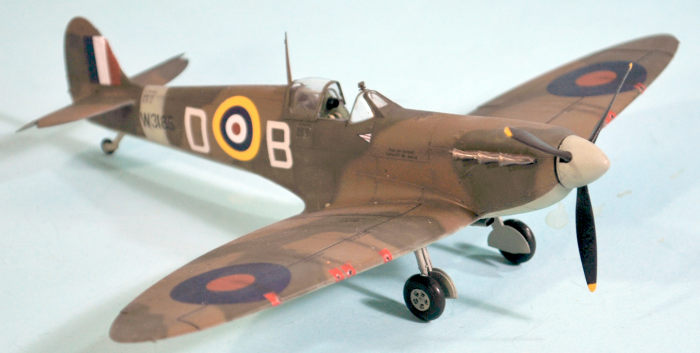 Douglas Bader arrived at RAF Tangmere on Marych 18, 1941, assigned to
take the newly-created post of Wing Commander (Flying) of the Tangmere Wing,
which consisted of 145 Squadron (Sqn Ldr Jack Leather) and 616 Squadron (Sqn Ldr
H.F. “Billy” Burton) based at Tangmere. and 610 (Sqn Ldr John Ellis) based at
Tangmere’s satellite field Westhampnett. All three squadrons were equipped with
Spitfire IIAs and Bs. With the improving spring weather, 145 Squadron was moved
a mile south to the newly opened Merston satellite field, while 616 Squadron
joined 610 at Westampnett. In mid-April, Sqn Ldr Paddy Woodhouse took over 610
from John Ellis and Sqn Ldr Stan Turner, a Canadian who had flown with Bader in
242 Squadron took over 145 Squadron.
Douglas Bader arrived at RAF Tangmere on Marych 18, 1941, assigned to
take the newly-created post of Wing Commander (Flying) of the Tangmere Wing,
which consisted of 145 Squadron (Sqn Ldr Jack Leather) and 616 Squadron (Sqn Ldr
H.F. “Billy” Burton) based at Tangmere. and 610 (Sqn Ldr John Ellis) based at
Tangmere’s satellite field Westhampnett. All three squadrons were equipped with
Spitfire IIAs and Bs. With the improving spring weather, 145 Squadron was moved
a mile south to the newly opened Merston satellite field, while 616 Squadron
joined 610 at Westampnett. In mid-April, Sqn Ldr Paddy Woodhouse took over 610
from John Ellis and Sqn Ldr Stan Turner, a Canadian who had flown with Bader in
242 Squadron took over 145 Squadron.
The same month, Group Captain A.B. “Woody” Woodhall arrived at Tangmere as Station Commander and Chief Controller, a post he had held at Duxford when Bader was there. Woodhall was known for inspiring confidence in the squadrons he was controlling with his unhurried and confident manner on the radio and for allowing the leader in the air to make his own decisions after giving him the necessary information. Bader, as he had done at Duxford during the Battle of Britain, elected to fly mainly with 616 Squadron. He flew with two pilots who made their name later in the war” Flying Officer Hugh “Cocky” Dundas and Pilot Officer James Edgar “Johnnie” Johnson. Dundas later became the RAF’s youngest Group Captain leading Typhoons and Johnson the RAF’s highest-scoring fighter pilot.
In early June 1941 Ken Holden, a flight commander in 616 Squadron, was promoted Squadron Leader and took over 610 Squadron, completing Bader’s team for the summer’s operations. About this time, a notice appeared on 616’s ‘A’ Flight notice board: “Bader’s Bus Company – daily tickets to the Continent – Return tickets only” “Bus Company” may have been to do with the Wing’s radio call sign, “Green Line Bus.” On taking command, Bader ordered that all squadrons should use the “Finger Four,” formation, adopted from the Luftwaffe.
With the Luftwaffe failing to respond to fighters, a new mission known
as a “Circuse” was developed. In a Circus, 4-6 Blenheim IV bombers from 2 Group
were escorted by fighter wings providing high and close cover, the formation
being known as a “Beehive.”. The Wings were tasked to provid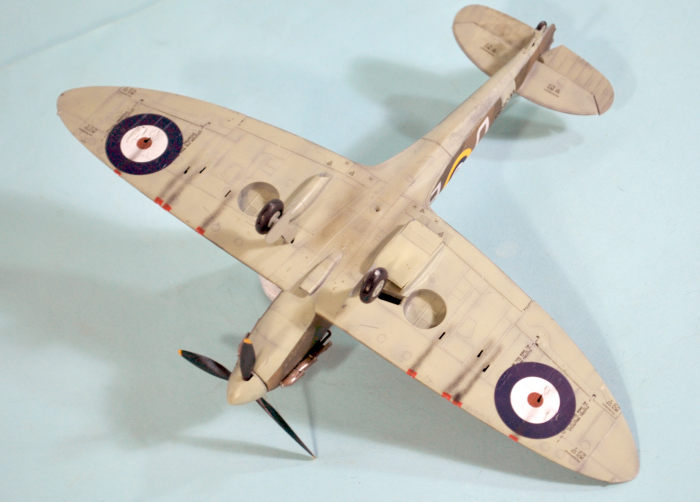 e “top cover”:
“penetration” as they flew into France, “target support” in the target area and
“withdrawal support” as the Beehive left the target. When covering a Circus, the Tangmere Wing operated with the three squadrons flying at different levels;
depending on the time of day the Wing would cross the French coast at a point
where it was best advantaged with regards to the sun. In a morning operation the
Wing would aim to cross in both directions near the French town of Gravelines
and in the afternoon near the port of Boulogne.
e “top cover”:
“penetration” as they flew into France, “target support” in the target area and
“withdrawal support” as the Beehive left the target. When covering a Circus, the Tangmere Wing operated with the three squadrons flying at different levels;
depending on the time of day the Wing would cross the French coast at a point
where it was best advantaged with regards to the sun. In a morning operation the
Wing would aim to cross in both directions near the French town of Gravelines
and in the afternoon near the port of Boulogne.
By June 1941 the Circuses, usually conducted twice a day, were well under way. The missions were called “The Non-Stop Offensive” by the RAF and in the press, while the Luftwaffe more accurately termed them “The Nonsense Offensive.” In truth, they accomplished little. The Germans could pick their time to attack or not, while the RAF fighters were tied down to close escort of the Blenheims, with their pilots closely watching their gas gauges. The RAF was unable to penetrate past the coastal belt of airfields and only had some 10 minutes’ combat time available to each of the three wings - “penetration,” “target” and “return” - that made the mission. The Blenheims only carried 1,000 pound bomb loads, and were easy to shoot down, while the damage they did was quickly repaired. Adolf Galland’s favorite tactic was to use the Bf-109's altitude advantage to dive through the escorts and knock down a Blenheim, continuing his dive away from the formation before the defending fighters could get organized. A few missions were flown with the new Stirling four-engine bombers acting as “bait,” but they turned out to be almost as vulnerable as the Blenheims and were quickly put back on night operations only.
Additionally, the Luftwaffe re-equipped the Channel Geschwadern with the Bf-109F-2, which outperformed the Spitfire II, and which the Spitfire V that was on its heels in re-equipping RAF squadrons was hard-pressed to keep up with. The Germans were well able to maintain air control over the Channel Front with two Jagdgeschwader - JG 2 on the Cotentin Peninsula and JG 26 at Abbeville.
For the Tangmere Wing, a typical day was June 25, 1941, when they covered Circus 22 between 1200-1300 hours. On crossing the French coast contact was made with 30-plus Bf 109s near Gravelines. In the ensuing battle 610 Squadron claimed one Bf 109 destroyed and one probable. Bader, flying with 616, claimed one Bf 109 destroyed and one shared with his No 2, Sergeant Jeff West. Other claims by 616 Squadron were two probables and two damaged. On the evening of the same day the Wing flew cover for Circus 23. About 15 miles inland, Bader was warned of 12 Bf 109s approaching from the east. In the ensuing battle, 610 Squadron claimed two enemy destroyed and two damaged; 145 claimed two destroyed and two damaged, one destroyed credited to Stan Turner. 616 was not so lucky, with two Sergeant Pilots shot down and killed, while a third Sergeant Pilot was lucky to reach Hawkinge after his Spitfire had been severely damaged when jumped by two Bf 109s. Bader attacked a group of four Bf 109s with his No 2, Flt Sgt Alan Smith, in the Boulogne area and claimed one destroyed.
Circus operations continued during July and early August, while Tangmere Wing’s Spitfire IIs were replaced with cannon armed Spitfire Vs with more powerful Merlin 45 engines. Bader, not believing in the value of cannon, flew a Mk VA armed with the standard eight machine guns. On July 28, the day the new Spitfires arrived, there was a major change to the wing: 145 Squadron was replaced by another experienced squadron, 41, led by Sqn Ldr Donald Finlay. Four days later Finlay was promoted to acting Wing Commander and Sqn Ldr Elmer Gaunce, a Canadian, took over the squadron.
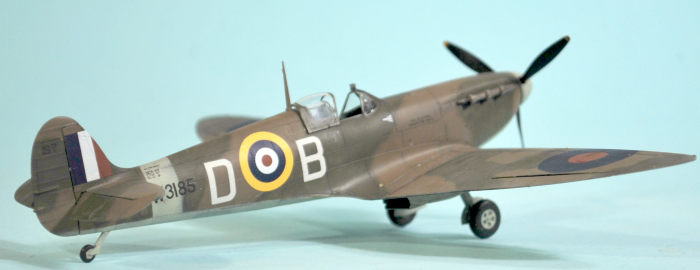 On August 9, 1941, the wing was tasked with providing target support for
Circus 68, a raid on Gosnay, near St Omer, one of JG 26's operating fields.
Bader took off with 616 Squadron, but with Flt Sgt Jeff West as No 2, his normal
No 2, Sgt Alan Smith, being unavailable.
On August 9, 1941, the wing was tasked with providing target support for
Circus 68, a raid on Gosnay, near St Omer, one of JG 26's operating fields.
Bader took off with 616 Squadron, but with Flt Sgt Jeff West as No 2, his normal
No 2, Sgt Alan Smith, being unavailable.
As 616 and 610 Squadrons set course, 41 failed to join up. As they crossed the French coast, Bf 109s were seen to port and below. 616 attacked, covered by 610, but were bounced by other Bf 109s before 610 could intervene. In the ensuing dogfight (Johnny Johnson said later it was the closest he ever dame to having a mid-air collision), 616 B Flight Commander, Flt Lt “Buck” Casson, was shot down.
Bader failed to return. Exactly what happened remains a mystery. Bader maintained he had a mid air collision with a Bf 109. Adolf Galland, maintained that Bader had been shot down by one of his pilots in the chaotic aerial battle that day, which Bader never accepted though it is now considered accjurate. After a struggle to get out of his cockpit and leaving one of his metal legs behind, Bader was able to parachute safely, landing near St Omer. Casson also survived a crash landing near Marquise.
The Germans notified the British via the Red Cross that Bader was a prisoner on August 14, offering free passage for an RAF aircraft to deliver a spare leg for Bader to Audembert, but the spare leg was dropped by parachute from a Blenheim on August 19 during a Circus operation to Longuenesse.
Don Finlay led the first mission after Bader’s loss; he was replaced by Paddy Woodhouse on August 14. On August 29, 610 Squadron left Westhampnett for Leconfield, replaced by 129 Squadron. On October 6, 616 Squadron left, replaced by 65 Squadron. “Bader’s Bus Company” was no more.
| THE KIT |
Eduard’s “Spitfire Story: Tally Ho!” two-fer kit came out earlier this year, offering a modeler a Spitfire IIa and a Spitfire Iib. I got two, doing what was in the box with the first ones, then doing a Spitfire Vb from the second kit. All the parts are in the kit to do Spitfire V - Va and Vb - if a modeler knows enough about the airplane to identify the relevant parts.
| CONSTRUCTION |
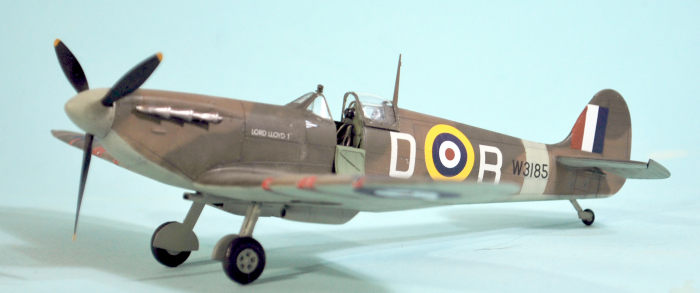 The road to a Spitfire Va starts with using the Spitfire IIa kit and
following the instructions, other than the following changes:
The road to a Spitfire Va starts with using the Spitfire IIa kit and
following the instructions, other than the following changes:
1. Do not attach part S34, the fairing over the Coffman starter.
2. Use Parts S9 and S10, with interior parts S11 and S12, for the oil cooler.
3. Use the deHavilland prop, parts P23-24 and R34.
4. Use the “fishtail” exhausts S2 and S3.
5. Use the metal ailerons parts S18 and S21.
Voila! You have a Spitfire Va.
Remember that these kits are designed to almost zero tolerance, so you MUST cut off all sprue nubs and be certain the mating surfaces of each part is completely clean, otherwise problems will grow like a snowball rolling downhill.
| COLORS & MARKINGS |
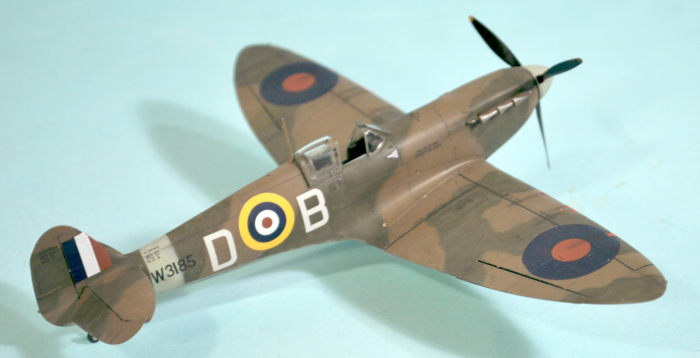 By the time the Spitfire V series came along, the camouflage scheme had
become the Scheme A only (According to the classic Camouflage and Markings book
on Spitfires in Northern Europe). The first ones that came off the production
lines in the spring and summer of 1941 were in Dark Earth/Dark Green/Sky finish.
I used my Tamiya mixture for Dark Earth, RAF Dark Green XF-82, and Tamiya Sky
suitably lightened to the proper shade.
By the time the Spitfire V series came along, the camouflage scheme had
become the Scheme A only (According to the classic Camouflage and Markings book
on Spitfires in Northern Europe). The first ones that came off the production
lines in the spring and summer of 1941 were in Dark Earth/Dark Green/Sky finish.
I used my Tamiya mixture for Dark Earth, RAF Dark Green XF-82, and Tamiya Sky
suitably lightened to the proper shade.
Now you just need decals for Bader’s airplane W3185, D-B, which I got from Lifelike Decals 48-026 “Supermarine Spitfire Part 4." I used national insignia from my declining stock of “Spitfire: Aces of the Empire” sheets. Everything melted into the surface detail under an application of Solvaset.
I gave the model a coat of clear flat, then attached the landing gear and exhausts. I unmasked the canopy and attached the sliding hood in the open position, then glued the prop on.
| CONCLUSIONS |
I really like Eduard’s Spitfires - they make up into the models I always wanted of my favorite airplane. This Spitfire Va can be done from the Spitfire IIa Profipack kit that is out should you want to; everything’s there in the box. I’m really looking forward to the coming Spitfire Vb and Vc (the first time this one has been done in a mainstream injection kit!). Recommended to everyone who likes Spitfires.
5 August 2021
Copyright ModelingMadness.com. All rights reserved. No reproduction in part or in whole without express permission
Review kit courtesy of my wallet.
If you would like your product reviewed fairly and fairly quickly, please contact the editor or see other details in the Note to Contributors.